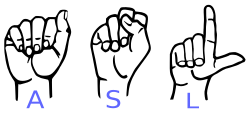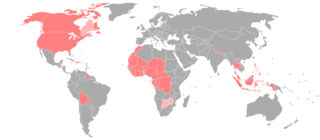
Back لغة الإشارة الأمريكية Arabic Llingua de signos americana AST آمریکا ایشاره دیلی AZB Амэрыканская жэставая мова BE-X-OLD Yezh ar Sinoù Amerikanek Breton Llengua de signes estatunidenca Catalan Lingua di i cenni americana Corsican Амслен CV Iaith Arwyddion America Welsh ASL Danish
| American Sign Language | |
|---|---|
| Visual American Sign Language | |
 | |
| Native to | United States, Canada |
| Region | Anglo-America |
| Signers | Native signers: 730,000 (2006)[1] L2 signers: 130,000 (2006)[1] |
| Dialects | |
| None are widely accepted si5s (ASLwrite), ASL-phabet, Stokoe notation, SignWriting | |
| Official status | |
Official language in | none |
Recognised minority language in | |
| Language codes | |
| ISO 639-3 | ase |
| Glottolog | asli1244 ASL familyamer1248 ASL proper |
 Areas where ASL or a dialect/derivative thereof is the national sign language Areas where ASL is in significant use alongside another sign language | |
American Sign Language (ASL) is a natural language[4] that serves as the predominant sign language of deaf communities in the United States and most of Anglophone Canada. ASL is a complete and organized visual language that is expressed by employing both manual and nonmanual features.[5] Besides North America, dialects of ASL and ASL-based creoles are used in many countries around the world, including much of West Africa and parts of Southeast Asia. ASL is also widely learned as a second language, serving as a lingua franca. ASL is most closely related to French Sign Language (LSF). It has been proposed that ASL is a creole language of LSF, although ASL shows features atypical of creole languages, such as agglutinative morphology.
ASL originated in the early 19th century in the American School for the Deaf (ASD) in Hartford, Connecticut, from a situation of language contact. Since then, ASL use has been propagated widely by schools for the deaf and Deaf community organizations. Despite its wide use, no accurate count of ASL users has been taken. Reliable estimates for American ASL users range from 250,000 to 500,000 persons, including a number of children of deaf adults and other hearing individuals.
ASL signs have a number of phonemic components, such as movement of the face, the torso, and the hands. ASL is not a form of pantomime although iconicity plays a larger role in ASL than in spoken languages. English loan words are often borrowed through fingerspelling, although ASL grammar is unrelated to that of English. ASL has verbal agreement and aspectual marking and has a productive system of forming agglutinative classifiers. Many linguists believe ASL to be a subject–verb–object language. However, there are several alternative proposals to account for ASL word order.
- ^ a b American Sign Language at Ethnologue (25th ed., 2022)

- ^ Province of Ontario (2007). "Bill 213: An Act to recognize sign language as an official language in Ontario". Archived from the original on 2018-12-24. Retrieved 2015-07-23.
- ^ Education Policy Counsel at National Association of the Deaf. "States that Recognize American Sign Language as a Foreign Language" (PDF). Archived (PDF) from the original on 2022-10-09. Retrieved 13 February 2022.
- ^ About American Sign Language Archived 2013-05-19 at the Wayback Machine, Deaf Research Library, Karen Nakamura
- ^ "American Sign Language". NIDCD. 2015-08-18. Archived from the original on 2016-11-15. Retrieved 2021-03-08.
© MMXXIII Rich X Search. We shall prevail. All rights reserved. Rich X Search